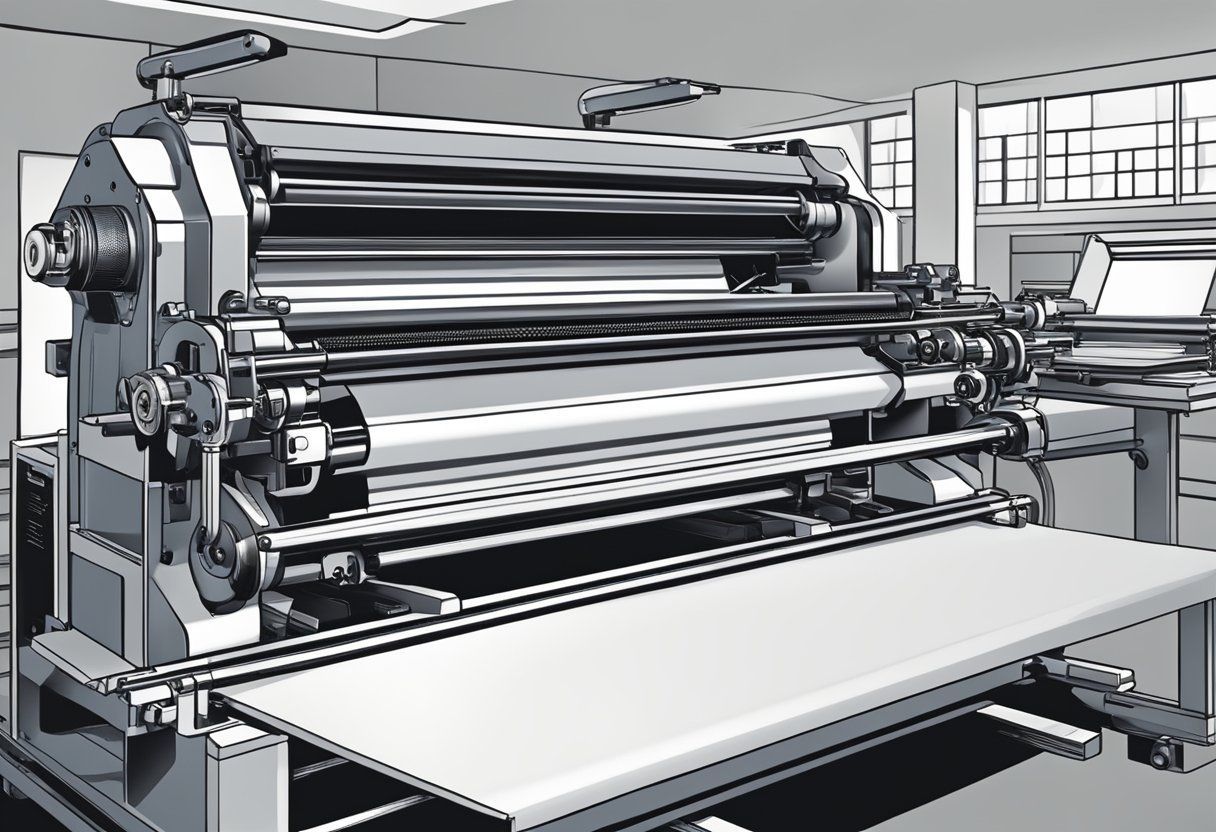Printed Catalogs as a Marketing Tool: Enhancing Engagement and Driving Sales
Printed catalogs have become a significant marketing tool for businesses aiming to capture customer interest and drive sales. These catalogs can effectively engage targeted audiences through tangible, visually appealing content that stands out in a digital world . As many consumers are inundated with online advertisements, printed catalogs offer a refreshing alternative that can lead to increased engagement and sales.

The design and content of these catalogs play crucial roles in their success. By focusing on the preferences of the target audience, businesses can create catalogs that not only showcase their products but also tell compelling stories that resonate with readers. This personalized approach enhances the impact of direct mail campaigns , making printed catalogs a worthwhile investment for many industries.
As companies look for effective ways to market their products, leveraging the emotional and psychological impact of physical catalogs can yield powerful results. Integrating printed catalogs with digital marketing strategies can further enhance their effectiveness, creating a well-rounded approach that captures attention and drives action.
Key Takeaways
- Printed catalogs effectively engage customers in a way digital marketing often cannot.
- Thoughtful design and targeted content increase the impact of printed catalogs.
- Combining printed catalogs with online marketing amplifies overall marketing efforts.
The Role of Printed Catalogs in Modern Marketing
Printed catalogs have a unique place in marketing today. They complement digital strategies by offering tangible experiences that engage customers. This blending of print and digital marketing has proven effective in building brand awareness and driving sales.
Defining Catalog Marketing
Catalog marketing involves creating and distributing printed materials that showcase products and services. This medium helps brands tell their stories in a visually appealing manner. Through well-designed layouts and imagery, catalogs can highlight features and benefits, making products more attractive.
Notably, catalog marketing strengthens brand identity. Consistent design elements, such as colors and logos, reinforce recognition. When consumers see these familiar elements, they are more likely to remember and trust the brand.
Printed vs. Digital Marketing Channels
Both printed and digital marketing channels serve different purposes. Printed catalogs offer a tactile experience that digital formats often lack. Customers can physically interact with catalogs, enhancing their connection to the products.
On the other hand, digital marketing enables instant access and can reach a broader audience quickly. However, many consumers still appreciate receiving printed materials in their mailboxes. This combination allows brands to target their audiences effectively by using each channel’s strengths.
E-commerce and Catalog Integration
Printed catalogs also play a vital role in e-commerce. They can drive traffic to online stores by including QR codes or links that direct customers to specific products. This integration merges the tangible experience of a catalog with the convenience of online shopping.
Moreover, catalogs can support cross-channel marketing campaigns. They can feature exclusive online offers, encouraging readers to visit the website. This approach not only boosts e-commerce sales but also enhances brand loyalty by providing cohesive marketing experiences.
Designing Effective Printed Catalogs
Creating an effective printed catalog requires careful consideration of design elements, visuals, and the choice of materials. These aspects play a vital role in capturing attention and conveying the brand message clearly.
Elements of Catalog Design
Catalog design begins with a clear layout. The organization of content should guide the reader’s eye. Utilizing grids can help maintain structure. Important elements include titles, product descriptions, and prices. Each should be easy to find.
Typography matters as well; it should match the brand’s aesthetic. Consistency in font size and style creates a cohesive look.
Colors play a crucial role too. They should resonate with the brand identity while ensuring readability. Contrast between background and text enhances visibility.
Using white space effectively prevents overcrowding and allows for better focus on key products.
The Importance of High-Quality Visuals
High-quality images are essential in printed catalogs. They serve as the first impression and can influence buying decisions.
Images should be clear, well-lit, and show products from various angles. This gives the customer a realistic view of what to expect.
Incorporating lifestyle images can help customers envision products in their own lives. For example, a furniture catalog might show a sofa in a home setting.
Inks used for printing must be vibrant and true to the product’s colors. They should also be long-lasting to maintain the catalog’s appeal over time.
This quality directly impacts how the brand is perceived in the market.
Choosing the Right Print Materials and Textures
The choice of print materials significantly affects the catalog’s overall quality. Lightweight paper might reduce costs but could feel flimsy.
Instead, opt for heavier stocks that convey stability.
Textures also influence tactile experience. For example, a glossy finish can enhance vibrant images, while matte paper may provide a sophisticated feel.
Brands should consider the environmental impact of their choices, opting for sustainable materials when possible. This not only attracts eco-conscious consumers but aligns with modern values.
The right print materials and textures can elevate the catalog’s look, making it memorable and engaging.
Target Audience and Personalization

Understanding the target audience is essential for effective marketing using printed catalogs. Personalizing content for specific customer segments ensures that the marketing message resonates and engages potential buyers.
Identifying Customer Segments
To reach the right customers, businesses should start by analyzing their current customer base. This involves examining demographic factors such as age, gender, location, and buying behavior.
Using customer data allows marketers to segment the audience into groups with similar interests or needs. For instance, a company might identify segments such as first-time buyers , loyal customers , and occasional shoppers .
Data-driven insights can help businesses tailor catalogs to meet each segment’s preferences. This targeted approach increases the likelihood of eliciting a positive response from customers.
Customized Content for Target Groups
After identifying customer segments, businesses can create customized content that speaks directly to each group’s interests. This could include personalized product recommendations or special offers designed for specific demographics.
Catalog features can be structured to cater to different groups. For instance, a catalog aimed at young adults might focus on trendy items, while one targeted at families highlights products for children.
Additionally, using personalized landing pages can further enhance the shopping experience. These pages can showcase items based on previous purchases or browsing history, leading to higher engagement and sales.
By prioritizing customer preferences and tailoring content, businesses can strengthen their connection with customers and improve marketing effectiveness.
Catalog Content Strategy

A strong catalog content strategy focuses on delivering informative product details and effective promotional offers. This approach will engage customers and encourage purchasing decisions.
Developing Informative Product Descriptions
Product descriptions should be clear and informative. They must highlight key features and benefits. Each description should briefly explain what the product is, how it works, and why it’s valuable. Important aspects include size, color, materials, and intended use.
Using bullet points can enhance readability. For example:
- Material: Eco-friendly cotton
- Dimensions: 12″x12″
- Best Use: Home decoration
Including customer reviews can also add credibility. When shoppers see positive feedback from others, they may feel more confident making a purchase.
It’s essential to avoid jargon. Descriptions should be straightforward, allowing all customers to understand the products easily.
Incorporating Promotional Offers
Promotions can significantly drive sales. Including promotional offers within the catalog creates a sense of urgency and entices customers to act. Clear visibility is key; the offers should be upfront and easy to find.
Types of promotions to consider:
- Discounts: Percentage or dollar amount off the original price
- Bundles: Buy one, get one free
- Limited-time offers: Special pricing for a short period
Each promotional section should include a brief explanation about the offer’s terms. For instance, clearly state the expiration date and any restrictions. Using bright colors or bold fonts can help these offers stand out.
By strategically placing these promotions, the catalog can capture more attention and drive sales.
Maximizing Catalog Impact through Distribution

Effective distribution is crucial for the success of printed catalogs. By utilizing the right strategies and tracking response rates, businesses can enhance their marketing efforts and boost sales.
Strategies for Direct Mail Distribution
Direct mail campaigns are a powerful way to reach customers. To maximize impact, targeting the right audience is key. Businesses should segment their mailing lists based on demographics, buying habits, and interests. Customizing catalogs for specific audience segments increases engagement.
Timing also plays a vital role. Sending catalogs during peak shopping times, like holidays or sales events, can enhance visibility. Including a clear call to action (CTA) encourages recipients to respond, whether through a website visit or a phone call.
Utilizing quality mailing services ensures that catalogs are delivered promptly and accurately. Employing unique design elements can also capture attention and make the mail stand out.
Tracking and Improving Response Rates
Tracking response rates allows businesses to measure the effectiveness of their campaigns. Tools like unique codes or QR codes in catalogs can help identify which designs or distributions yield the best results.
Email campaigns can supplement direct mail efforts. A follow-up email can remind customers about the catalog and encourage online browsing. It’s important to analyze the data collected to make informed adjustments.
Using feedback from customers can provide insights into preferences, which can improve future catalog designs. Regularly reviewing response rates helps in developing strategies for better engagement and higher sales.
Pricing and Cost-Effectiveness

When considering printed catalogs as a marketing tool, understanding the costs involved is crucial. This section explores the various printing methods and their costs, as well as the importance of balancing cost and quality in catalog production.
Understanding Printing Methods and Costs
The printing method chosen affects both the quality and cost of printed catalogs. Common methods include digital printing and offset printing. Digital printing is often more affordable for smaller runs but has limitations in paper choices and finish options. Offset printing, while suited for larger quantities, generally has higher setup costs.
Budgeting for catalog marketing requires a clear understanding of printing costs. Factors include paper type, ink quality, and layout complexity. Companies should expect a range of costs depending on these choices. For example, premium paper and full-color printing can increase costs significantly. Catalog producers can optimize costs by requesting quotes from multiple printing companies.
Balancing Cost and Quality
Achieving a balance between cost and quality is essential for effective marketing. While lower-cost options may seem appealing, they can sacrifice quality, potentially affecting customer perception. It’s important for businesses to weigh the long-term value of high-quality materials.
Mailing costs also contribute to the overall budget. Factors such as size, weight, and mailing method influence these expenses. Businesses must consider postage rates, especially for bulk mailings. For example, using standard mail services can lower costs compared to expedited options. Ultimately, companies should invest in quality that resonates with their audience while staying within budget constraints.
The Psychological Impact of Physical Catalogs

Physical catalogs have a distinct ability to influence consumer behavior through emotional connections and trust-building. They serve as tangible representations of a brand’s identity and values. This section explores how catalogs foster brand loyalty and create narratives that resonate with consumers.
Building Brand Loyalty through Tangible Materials
Printed catalogs reinforce brand identity by providing a physical touchpoint that engages consumers. The act of holding a catalog creates a more profound connection than digital formats can. When consumers can physically interact with a product, it builds trust and credibility.
Key factors include:
- Consistency : A well-designed catalog reflects a brand’s aesthetic, ensuring that the visuals align with other marketing materials.
- Memorability : Tangible materials leave a lasting impression. Consumers are more likely to remember a brand after interacting with its catalog.
- Value : Receiving a physical catalog can enhance perceived value, making consumers feel special and connected.
This loyalty leads to repeat purchases and word-of-mouth referrals, crucial for long-term business success.
Creating an Emotional Narrative
Physical catalogs excel at storytelling by offering a platform for brands to convey their values and mission. Through carefully curated imagery and messaging, catalogs can evoke emotions and create a narrative that resonates with consumers.
Elements to consider:
- Visual Appeal : Engaging images can capture attention and stimulate an emotional response, fostering a connection.
- Brand Story : A well-told story about the brand’s origins or values humanizes the business, allowing consumers to relate more deeply.
- Personalization : Modern catalogs often include personalized elements, such as tailored offers, which can make consumers feel valued and understood.
These emotional connections are essential for developing a loyal customer base, ultimately leading to increased sales and brand advocacy.
Advantages of Printed Catalogs over Online Marketing
Printed catalogs offer distinct benefits that set them apart from online marketing. They engage customers in a way that digital ads often cannot, making a deeper connection. Catalogs can have a longer shelf life, allowing potential buyers to revisit them.
Printed Catalogs in the Age of Online Shopping
In the crowded digital landscape, printed catalogs stand out. They provide a tangible experience that online advertisements lack. Many consumers appreciate being able to physically hold a catalog. This interaction can lead to a stronger emotional connection with the brand.
Research shows that printed materials often have a longer shelf life than digital content. Customers may keep catalogs for weeks or months, flipping through the pages periodically. This repeated exposure can reinforce brand recognition and influence purchasing decisions.
Additionally, catalogs allow businesses to showcase their products in a curated format. Instead of a quick scroll through an online feed, consumers can take their time to browse. This immersive experience can lead to increased sales, as customers feel more engaged.
Making a Lasting Impression with Tangible Marketing Materials
Tangible marketing materials like catalogs create a lasting impression. They provide an immersive experience that digital ads struggle to achieve. When customers receive a beautifully designed catalog, it captures their attention.
A catalog can effectively highlight promotions, unique product features, and brand storytelling. This presentation style can enhance customer understanding of what the brand offers. Notably, printed catalogs can resonate more deeply, resulting in higher retention rates.
Furthermore, they can be shared easily. Customers may pass them to friends and family, extending their reach. This word-of-mouth promotion is invaluable and often outperforms digital shares.
In essence, printed catalogs are more than just marketing tools. They create connections, stay in homes longer, and leave lasting impressions.
Integrating Catalogs with Other Marketing Channels

Combining printed catalogs with other marketing channels enhances the overall impact of marketing strategies. By using technology and digital media, businesses can create cross-selling opportunities that drive more sales and engage customers effectively.
Catalogs and QR Code Technology
QR codes provide a modern way to blend print and digital media. By placing QR codes in printed catalogs, businesses can drive customers to online content, such as video demonstrations or additional product details.
This technology enables instant access to a broader range of information, which can enhance the shopping experience. Customers can scan a code to find alternate options, promotions, or even customer reviews. Implementing QR codes allows for measurable engagement, as businesses can track scans to gauge interest and adjust strategies accordingly.
Combining Print and Digital Marketing Efforts
Using catalogs alongside digital marketing efforts creates a cohesive customer journey. For instance, a retailer can promote a new catalog through email campaigns or social media ads. This synergy drives customers to their printed materials while bridging the gap to the online store.
Additionally, combining strategies promotes cross-selling opportunities. A catalog can highlight best-selling items, while digital platforms can suggest related products. This approach not only nurtures customer interest but also provides a more personalized shopping experience. By integrating these channels, businesses can strengthen their marketing strategies and build a lasting connection with their audience.
Catalogs in Different Industry Applications
Printed catalogs serve various functions across different industries, providing specific advantages that cater to unique market needs. They are instrumental in showcasing products and services effectively, whether in retail, services, or trade environments.
Retail Catalog Marketing Examples
Retailers often use catalogs to highlight seasonal promotions, new arrivals, or exclusive items. For example, a clothing store may produce a vibrant catalog featuring their latest collection, allowing customers to browse at their leisure.
These catalogs can be mailed directly to customers or available in-store. The visuals, combined with clear pricing and descriptions, make it easy for shoppers to make informed buying decisions. Printed catalogs also encourage impulse purchases, as enticing visuals can capture a customer’s attention, leading to immediate sales.
Utilizing Catalogs for Service Industry
In the service industry, catalogs can showcase offerings like spa treatments, home improvement services, or dining options. A landscaping company might create a catalog outlining various services, such as lawn care or garden design.
These catalogs provide potential customers with information about service packages, pricing, and seasonal offers. The inclusion of customer testimonials and vibrant images enhances credibility and appeal. By distributing catalogs in local communities, businesses can reach a wider audience and attract new clients.
B2B Catalogs for Trade Shows and Events
Trade shows are crucial for business-to-business (B2B) marketing, allowing companies to meet potential clients face-to-face. B2B catalogs are often used to present products and services at these events. For example, an auto parts supplier may distribute a detailed catalog that lists all available parts, complete with specifications and applications.
These catalogs not only serve as handouts but also as conversation starters during discussions. They showcase the company’s offerings, collect leads, and encourage connections. Providing physical catalogs at trade shows leaves a lasting impression, making it easier for businesses to follow up with potential clients later.
Measuring the Success of Catalog Marketing
To effectively measure the success of catalog marketing, businesses need to focus on specific metrics that reflect their sales performance and marketing effectiveness. Understanding how catalogs drive sales and establishing clear marketing goals is essential for assessing their impact.
Quantifying Catalog-Driven Sales
One way to measure the success of a catalog is by tracking sales directly linked to it. This can be done by assigning unique tracking numbers to each catalog sent out. When customers use these numbers to place orders, it allows businesses to see the exact catalog’s influence on sales.
Businesses can also analyze changes in sales numbers during the catalog’s lifespan. Comparing the sales data before and after the catalog’s release offers insights into its effectiveness. For example, if sales increased by 20% after sending out a catalog, this indicates a strong correlation.
Using metrics such as response rates, return on investment (ROI), and conversion rates from the catalog can further clarify its success. These figures help marketers understand which products attract the most interest and how catalogs contribute to overall sales goals.
Setting and Evaluating Marketing Goals
Clear goals are critical for effective catalog marketing. Businesses should define specific metrics like target sales volume, desired response rates, and timelines for their catalog campaigns.
Regularly evaluating these goals helps determine if the catalog strategy is effective. For instance, if a company aimed for a 15% increase in sales within three months and only achieved 5%, they may need to reassess their approach.
Using A/B testing can also be useful. By comparing different catalog designs or distribution methods, a business can pinpoint which tactics drive the best results. Adjusting marketing strategies based on performance data allows companies to refine their catalog campaigns continually.
Frequently Asked Questions
Printed catalogs offer unique benefits in marketing campaigns. They can enhance consumer engagement and provide tangible reference materials for customers. Below are key questions and answers regarding printed catalogs as a marketing tool.
What are the primary advantages of using printed catalogs in marketing?
One major advantage is their physical presence. Printed catalogs can be handed out at events or sent directly to customers, making them more memorable. They also provide a detailed showcase of products, allowing businesses to present their offerings in a visually appealing manner.
How do printed catalogs influence consumer behavior?
Printed catalogs can influence consumer behavior by presenting information in a structured and attractive way. Studies show that people tend to spend more time engaging with printed materials, which can lead to higher purchase intent. The ability to browse at leisure can also encourage customers to make impulse buys.
What are some effective examples of catalog marketing?
Effective examples include seasonal catalogs that highlight new arrivals or special promotions. Many businesses also use catalogs to provide in-depth information about their products, helping customers make informed decisions. High-quality design and strategic layout can greatly enhance these catalogs’ effectiveness.
What challenges do online retailers face that printed catalogs can solve?
Online retailers often struggle with customer retention and engagement. Printed catalogs help bridge the gap by providing a physical touchpoint that reminds customers of the brand. They can also cater to customers who prefer traditional shopping methods or who may not be tech-savvy.
What are the drawbacks of utilizing printed catalogs for marketing purposes?
One drawback is the cost associated with printing and distribution. Unlike digital marketing, which can be more budget-friendly, printed catalogs require significant investment. Additionally, the environmental impact of paper production and waste can also be a concern for some businesses.
In what ways are printed catalogs considered a significant marketing tool in today’s digital age?
Despite the rise of digital marketing, printed catalogs remain significant due to their tangible nature. They provide a break from screen fatigue and allow consumers to engage with products in a different way. Many consumers appreciate the physical experience of browsing through a catalog, which can enhance brand loyalty.…










